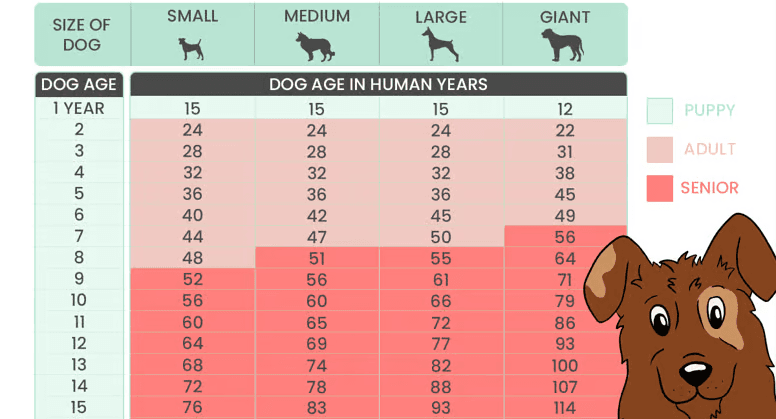When you think about your calculate dog age, do you ever wonder how old they would be if they were a human? Many people believe the idea that 1 dog year equals 7 human years, but it’s actually not that simple. Dogs age much faster in their early years, and the rate at which they age depends on their breed and size. Smaller dogs tend to live longer and age more slowly, while larger dogs age faster and often have shorter lifespans. Understanding how dogs age can help us take better care of them as they grow older.
In this guide, we’ll explain how to calculate your dog’s age in human years. We’ll break down the “7-year rule” and show you a more accurate way to figure out your dog’s age. We’ll also cover how different breeds and sizes affect the aging process and what you can do to help your dog live a long, healthy life. Whether you have a tiny Chihuahua or a large Golden Retriever, you’ll learn the best way to calculate their age in human years.
Read also: German Shepherd Husky Mix
The Truth Behind the “7-Year Rule”
You’ve probably heard that 1 dog year equals 7 human years. It’s a very common belief, but guess what? It’s not exactly true. The idea started because it was an easy way to explain how fast dogs age compared to humans, but science has shown that it’s not that simple.
In reality, dogs age much faster during their first few years of life. A puppy doesn’t grow at the same speed as a human baby. In just a couple of months, a puppy can go from newborn to toddler stage, while a human baby is still learning how to crawl!
Once a dog reaches adulthood, they start aging at a slower pace, but how fast they age depends on a few factors, including their breed and size. That’s why we can’t just say every dog year equals 7 human years.
Let’s look at how to accurately calculate dog years to human years.
How Dogs Age in the First Two Years
The first two years of a dog’s life are really important. In those first two years, dogs grow fast—super fast! It’s a little bit like a time machine for dogs. By the time a dog is just two years old, they’re roughly the same as a 24-year-old human!
Why do we say 24 years? Well, think about it. During those first two years, dogs go through what we call “puppyhood,” “childhood,” and “teenage years” in just a short time. That’s why young dogs seem so full of energy and sometimes get into trouble—they’re like teenagers who don’t know their own strength or limits yet.
After a dog turns two, their aging starts to slow down a little. But how much it slows down depends on the breed and size of the dog. Small dogs might age more slowly, while large dogs age faster.
Different Breeds, Different Speeds
Not all dogs age at the same rate. This is where things get interesting! A Chihuahua and a Great Dane don’t age the same way, even if they are both the same age in dog years. Why? It’s because breed and size play a huge role in how fast or slow a dog ages.
Here’s a quick guide:
- Small dogs (under 20 pounds): Small dogs, like Chihuahuas or Yorkies, usually live longer than big dogs. They age more slowly after the first two years. For them, each dog year after two equals about 4 human years.
- Medium dogs (20-50 pounds): Dogs like Beagles or Border Collies age a bit faster than small dogs but slower than big dogs. They age about 5 human years for each dog year after their second birthday.
- Large dogs (50-100 pounds): Large breeds like Golden Retrievers and German Shepherds tend to age more quickly. After the first two years, each dog year for them is equal to about 6-7 human years.
- Giant dogs (over 100 pounds): Massive dogs like Great Danes or Saint Bernards age the fastest. After the first two years, they can age as much as 9-10 human years for every dog year.
It’s pretty clear that size and breed make a big difference, but there’s more to the story.
How to Calculate Dog Years to Human Years
Now that we understand how different dogs age at different rates, it’s time to learn how to calculate your dog’s age in human years. Don’t worry—it’s easier than it sounds.
Step 1: Know Your Dog’s Real Age
First, you need to know your dog’s actual age in dog years. Let’s say your dog is 5 years old. That’s a good place to start.
Step 2: The First Two Years
Remember, the first two years of a dog’s life are equal to 24 human years. So, if your dog is exactly 2 years old, that’s like being 24 in human years.
Step 3: Add the Extra Years
Now, for every year after the second, you’ll add 4-7 human years depending on your dog’s size.
Let’s say your dog is 5 years old:
- The first 2 years = 24 human years.
- Then, for the next 3 years (since 5 – 2 = 3), add 4-7 years depending on your dog’s size.
If your dog is small (under 20 pounds), you add 4 years for each of the 3 years. That’s 12 more years (3 x 4). So, 24 + 12 = 36 human years.
If your dog is large (over 50 pounds), you might add 6 years for each of those 3 years. That’s 18 more years (3 x 6). So, 24 + 18 = 42 human years.

Examples of Dog-to-Human Age Calculations
Let’s go through a few examples so you can see how this works with different breeds.
Example 1: Small Dog – Chihuahua (6 Years Old)
- First 2 years = 24 human years.
- Next 4 years = 4 human years for each dog year.
- 4 x 4 = 16 human years.
- Total = 24 + 16 = 40 human years.
So, a 6-year-old Chihuahua is about 40 years old in human years.
Example 2: Medium Dog – Beagle (8 Years Old)
- First 2 years = 24 human years.
- Next 6 years = 5 human years for each dog year.
- 6 x 5 = 30 human years.
- Total = 24 + 30 = 54 human years.
So, an 8-year-old Beagle is around 54 years old in human years.
Example 3: Large Dog – Golden Retriever (10 Years Old)
- First 2 years = 24 human years.
- Next 8 years = 6 human years for each dog year.
- 8 x 6 = 48 human years.
- Total = 24 + 48 = 72 human years.
A 10-year-old Golden Retriever is about 72 years old in human years.
Example 4: Giant Dog – Great Dane (5 Years Old)
- First 2 years = 24 human years.
- Next 3 years = 9 human years for each dog year.
- 3 x 9 = 27 human years.
- Total = 24 + 27 = 51 human years.
So, a 5-year-old Great Dane is like a 51-year-old human.
Why Do Dogs Age Faster Than Humans?
Now that we’ve done some math, you might be wondering, “Why do dogs age so much faster than humans?”
It all comes down to biology. Dogs’ bodies develop much quicker than ours. Puppies grow rapidly in the first few months, reaching full size in just a year or two, while humans take nearly two decades to fully mature.
Another reason dogs age faster is their metabolism. Dogs, especially smaller breeds, have faster metabolisms than humans. Their hearts beat faster, and their bodies work harder, which means they “burn out” more quickly.
Larger dogs, while they have slower metabolisms compared to small dogs, tend to age faster due to their size. Bigger bodies mean more wear and tear on joints and organs, which can shorten their lifespan.
How Can We Help Dogs Live Longer?
While we can’t stop dogs from aging, we can help them live longer, healthier lives. Here are some simple things you can do to keep your dog feeling their best:
1. Provide Regular Exercise
Exercise is key to keeping your dog’s body strong and healthy. Whether it’s a daily walk or playtime in the yard, regular physical activity can improve your dog’s quality of life and even extend their lifespan.
2. Feed a Healthy Diet
What your dog eats plays a huge role in their overall health. Make sure to feed them high-quality dog food that provides all the nutrients they need. Avoid overfeeding or giving too many treats, as this can lead to obesity, which can shorten a dog’s life.
3. Schedule Regular Vet Visits
Taking your dog to the vet for regular check-ups can help catch health problems early. Routine exams can also ensure your dog’s vaccines are up to date and that they’re protected from common diseases.
4. Take Care of Their Teeth
Many dog owners overlook dental care, but it’s really important. Just like humans, dogs can develop dental problems, which can lead to pain, infection, and other health issues. Brushing your dog’s teeth regularly or giving them dental treats can help keep their teeth clean and healthy.
5. Provide Mental Stimulation
Dogs need mental stimulation just as much as physical exercise. Toys, puzzles, and training sessions can keep your dog’s brain sharp as they age.
Myths About Dog Aging
There are a lot of myths about dog aging that you might have heard. Let’s clear up a few of them.
Myth 1: All Dogs Age the Same Way
This is false. As we’ve discussed, small dogs, medium dogs, large dogs, and giant dogs all age at different rates. A one-size-fits-all rule for dog aging just doesn’t work.
Myth 2: One Dog Year Equals Seven Human Years
This myth has been around for a long time, but we now know it’s not accurate. The first two years of a dog’s life equal about 24 human years, and after that, their aging rate depends on their size.
Myth 3: A Dog’s Age Can Be Measured Just by Looking at Their Teeth
While vets may use a dog’s teeth to estimate their age, it’s not always accurate. The condition of a dog’s teeth can vary based on their diet, genetics, and dental care. Some older dogs may have better teeth than younger dogs if they’ve had regular dental care.
Wrapping It All Up
Dogs are amazing companions, and it’s important to understand how they age so we can give them the best care possible. While the “7-year rule” is a simple way to think about dog years, it’s not the most accurate. By learning how different breeds and sizes age, you can better understand what stage of life your dog is in and how to take care of them as they grow older.
The next time someone asks you how old your dog is in human years, you’ll know exactly how to answer—and impress them with your knowledge!
FAQs
1. How do I calculate my dog’s age in human years?
Start by adding 24 human years for the first two years of your dog’s life. Then, depending on your dog’s size, add 4-9 human years for each dog year after that.
2. Is the 7-year rule true?
No, the 7-year rule is a myth. Dogs age faster in their first two years, and the rate after that depends on their breed and size.
3. Do small dogs live longer than large dogs?
Yes, generally, small dogs live longer than large dogs because they age more slowly after the first two years.
4. What’s the oldest a dog can live?
Some small dogs can live up to 20 years or more, while larger dogs usually live around 10-15 years.
5. Why do dogs age faster than humans?
Dogs age faster due to their faster metabolism and quicker growth during their early years. Their bodies develop much faster than human bodies.
6. Can a healthy diet help my dog live longer?
Yes! A healthy diet that provides the right nutrients can help your dog live a longer, healthier life.
7. How often should I take my dog to the vet?
It’s a good idea to take your dog to the vet at least once a year for a check-up. Older dogs may need more frequent visits to monitor their health.
8. Is it true that dogs age slower after their first two years?
Yes, after the first two years, dogs tend to age more slowly, but the rate depends on their size and breed.
9. Can regular exercise extend my dog’s life?
Absolutely! Exercise keeps your dog’s body and mind healthy, which can improve their quality of life and extend their lifespan.
10. Do dogs go through “teenage” years like humans?
Yes! The first two years of a dog’s life are similar to a human’s teenage years, full of energy and sometimes mischief.







